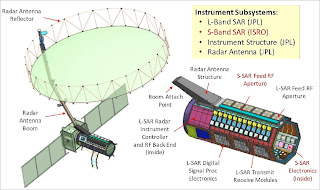What Is NISAR?
NISAR stands for National Information System for Agricultural Resources. It is an upcoming joint mission of the Indian Space Research Organisation (ISRO) and the National Aeronautics and Space Administration (NASA) of the United States. This mission aims to launch a satellite with a powerful synthetic aperture radar (SAR) system to provide high-resolution imaging and real-time information on agricultural resources and ground movement across the globe.
When And Where NISAR Will Launch?
The collaboration between ISRO and NASA was signed in September 2014, according to which NASA provides a high-rated communication subsystem for science data and some technical specifications also. But the satellite will be launched by India from Satish Dhawan Space Centre(SDSC) SHAR, Sriharikota on the southeast coast of the Indian peninsula, with the help of GSLV, contributed by ISRO.
The target is to launch the satellite in the month of January 2024.
Technical Specifications Of The Mission
The NISAR mission will use advanced technology in their satellite. The satellite will be equipped with two types of radar systems.
- L-band SAR:- This radar is built by NASA's Jet Propulsion Laboratory (JPL). It is a highly advanced radar that will operate at a longer wavelength and provide high-resolution imaging of vegetation and underlying terrain.
- S-band SAR:- This radar is built by ISRO and it will operate at a shorter wavelength, providing higher-resolution images of the Earth's surface and creating 3D images of the terrain. The satellite will operate in a low-earth orbit and collect data for a period of three years.

NISAR
Budget Of NISAR Mission
NISAR mission is a very advanced mission that is equipped high technology system so the total cost estimated is US $ 1.5 billion, which makes NISAR satellite counted as the world’s most expensive Earth-imaging satellite. ISRO’s share of the project cost is about 788 crore rupee(US $ 99 million), and NASA’s share is about Us $ 808 million.
But currently, The total expenditure incurred on the realization of the NISAR satellite by ISRO up to February 2023 is Rs 469.40 crore, excluding launch costs.
Benefits Of the Mission
The NISAR mission will have several benefits. It will enable farmers to make better decisions on crop planning, irrigation, and pest control. It will also help agricultural researchers to monitor soil moisture, crop health, and nutrient levels. The mission will provide valuable information on disaster management and early warning systems for earthquakes, landslides, and other natural disasters.
Strengthening the Partnership Between ISRO and NASA
The NISAR mission is a prime example of international collaboration between two space agencies. The mission is a symbol of the growing cooperation between the two countries in the area of science and technology. The partnership between ISRO and NASA has allowed for the exchange of technical expertise, sharing of resources, and the reduction in cost and risk for both agencies.
The NISAR mission is a crucial step in the development of advanced technologies for agriculture and disaster management. The collaboration between ISRO and NASA is a model for international cooperation and will benefit people across the globe. The mission will bring new insights into the earth's resources and help in building a sustainable future. With its advanced radar technology and powerful imaging capabilities, the satellite will be an invaluable resource for scientists and researchers around the world.
Thank You
by- Vidit Kumar Singh

